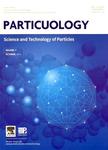Modeling particle sedimentation in viscous fluids with a coupled immersed boundary method and discrete element method
Modeling particle sedimentation in viscous fluids with a coupled immersed boundary method and discrete element method作者机构:Faculty of Mechanical Maritime and Materials Engineering Delft University of Technology Delft Netherlands Department of Mechanical Engineering Faculty of Engineering University of Isfahan Isfahan Iran
出 版 物:《Particuology》 (颗粒学报(英文版))
年 卷 期:2017年第15卷第2期
页 面:191-199页
核心收录:
学科分类:07[理学] 0817[工学-化学工程与技术] 0805[工学-材料科学与工程(可授工学、理学学位)] 0703[理学-化学] 0702[理学-物理学]
基 金:Iranian Ministry of Science Research and Technology [MSRT 100026-89]
主 题:Immersed boundary method Discrete element method Particle sedimentation Boycott phenomenon
摘 要:Numerical techniques have increasingly been used to model fluid–particle two-phase flows. Coupling the immersed boundary method (IBM) and discrete element method (DEM) is one promising approach for modeling particulate flows. In this study, IBM was coupled with DEM to improve the reliability and accuracy of IBM for determining the positions of particles during the sedimentation process within viscous fluids. The required ratio of the particle diameter to the grid size (D/dx) was determined by comparing the simulation results with the analytical solution and experimental data. A dynamic mesh refinement model was utilised in the IBM model to refine the computational fluid dynamics grid near the particles. In addition, an optimum coupling interval between the IBM and DEM models was determined based on the experimental results of a single particle sedimentation within silicon oil at a Reynolds number of 1.5. The experimental results and the analytical solution were then utilised to validate the IBM–DEM model at Reynolds numbers of 4.1, 11.6, and 31.9. Finally, the validated model was utilised to investigate the sedimentation process for more than one particle by modeling the drafting-kissing-tumbling process and the Boycott phenomenon. Benchmark tests showed that the IBM–DEM technique preserves the advantages of DEM for tracking a group of particles, while the IBM provides a reliable and accurate approach for modeling the particle–fluid interaction.



